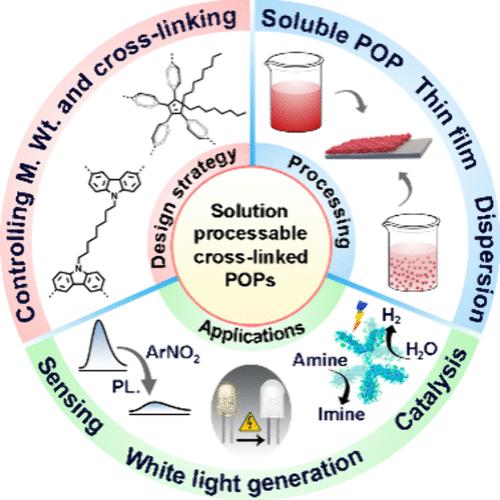当前位置:
X-MOL 学术
›
Acc. Mater. Res.
›
论文详情
Our official English website, www.x-mol.net, welcomes your
feedback! (Note: you will need to create a separate account there.)
Intriguing Facets of Solution Processable Cross-Linked Porous Organic Polymers
Accounts of Materials Research ( IF 14.0 ) Pub Date : 2024-09-18 , DOI: 10.1021/accountsmr.4c00197 Madhurima Sarkar 1 , Suprabhat Sarkar 1 , Monisha Saha 1 , Khushi Luvani 1 , Abhijit Patra 1
Accounts of Materials Research ( IF 14.0 ) Pub Date : 2024-09-18 , DOI: 10.1021/accountsmr.4c00197 Madhurima Sarkar 1 , Suprabhat Sarkar 1 , Monisha Saha 1 , Khushi Luvani 1 , Abhijit Patra 1
Affiliation

|
Porous organic polymers (POPs) are organic networks distinguished by their highly cross-linked structures and their intrinsic porosity. The growing emphasis on POPs is driven by their exceptional hydrothermal stability and diverse application prospects. However, traditional metal-catalyzed high-temperature reactions using rigid building units yield POPs in insoluble powder form, posing challenges for processing into different shapes for device integration and optoelectronic applications. The successful fabrication of a soluble porous organic polymer relies on the employment of specific design strategies and reaction conditions to restrict the molecular weight and extensive cross-linking. In recent decades, researchers have been actively exploring various design strategies, such as limiting molecular weight through hyperbranching and employing controlled polymer growth strategies, to produce solution processable amorphous porous organic polymers. However, targeted synthesis for specific applications remains underdeveloped, justifying the need for an in-depth deliberation of currently available strategies and possible future avenues. In this context, this Account highlights the advancements in the field of solution processable amorphous cross-linked porous organic polymers (SCPOPs), describing diverse design strategies and function-led applications. In order to address the challenges associated with the solution processing of amorphous cross-linked POPs, our research group has focused on fine-tuning the noncovalent interactions among the molecular building blocks, the key to achieving both porosity and solubility in the resultant porous polymer. Following this principle, we introduce long alkyl chains as flexible groups in the monomer and comonomer units that offer a high degree of rotational freedom and a substantial twist angle. This approach facilitates alleviation of the pronounced π–π stacking interaction and extensive cross-linking, thereby enhancing the solubility of the porous polymer. As a result, the facile interaction between the analytes and inefficiently packed polymer chains with aromatic building units in SCPOPs opens the scope for fluorescence-based nitroaromatic sensing in solution. Further, a stable dispersion of fluorescent porous polymer nanoparticles could be an attractive platform for analyte detection in water with enhanced sensitivity. The porous nature of the fluorescent SCPOPs enables the encapsulation of diverse dye molecules, and controlling the energy transfer efficiency from polymer to dyes results in fluorescence tuning, leading to the emission of white light in solution, nanoparticles, gel, and a thin transparent film. Furthermore, we demonstrate that incorporating alternate donor–acceptor units into the cross-linked polymer leads to the optimum band positions for light-driven redox reactions, such as photooxidation of benzylamine and hydrogen evolution. We investigated a biphasic catalysis route employing solution-processable POPs to enhance the efficiency while facilitating the recovery and reusability of the photocatalysts. As detailed in this review, the comprehensive inspection of the design strategies and potential applications of SCPOPs paves the way to delve into designing new processable functional porous materials, catering to the need for current sustainable development goals.
中文翻译:

可溶液加工交联多孔有机聚合物的有趣方面
多孔有机聚合物 (POP) 是一种有机网络,以其高度交联的结构和固有的孔隙率而著称。POPs 的日益重视是由其卓越的水热稳定性和多样化的应用前景推动的。然而,使用刚性建筑单元的传统金属催化高温反应会产生不溶性粉末形式的 POP,这对加工成不同形状的器件集成和光电应用构成了挑战。可溶性多孔有机聚合物的成功制备依赖于采用特定的设计策略和反应条件来限制分子量和广泛的交联。近几十年来,研究人员一直在积极探索各种设计策略,例如通过超支化限制分子量和采用受控聚合物生长策略,以生产可溶液加工的无定形多孔有机聚合物。然而,针对特定应用的靶向综合仍然不发达,因此有必要深入研究当前可用的策略和未来可能的途径。在此背景下,本报告重点介绍了可溶液加工非晶交联多孔有机聚合物 (SCPOP) 领域的进展,描述了不同的设计策略和功能导向的应用。为了解决与无定形交联 POP 的溶液处理相关的挑战,我们的研究小组专注于微调分子构建单元之间的非共价相互作用,这是在所得多孔聚合物中实现孔隙率和溶解度的关键。 遵循这一原理,我们在单体和共聚单体单元中引入长烷基链作为柔性基团,提供高度的旋转自由度和较大的扭转角。这种方法有助于减轻明显的 π-π 叠层相互作用和广泛的交联,从而提高多孔聚合物的溶解度。因此,分析物与低效堆积的聚合物链与 SCPOP 中的芳香族构建单元之间的简单相互作用为溶液中基于荧光的硝基芳烃传感开辟了范围。此外,荧光多孔聚合物纳米颗粒的稳定分散可能是一个有吸引力的水分析物检测平台,灵敏度更高。荧光 SCPOP 的多孔特性能够封装不同的染料分子,并控制从聚合物到染料的能量转移效率导致荧光调谐,导致在溶液、纳米颗粒、凝胶和透明薄膜中发射白光。此外,我们证明,将替代供体-受体单元掺入交联聚合物中可导致光驱动氧化还原反应的最佳谱带位置,例如苄胺的光氧化和析氢。我们研究了一种采用可溶液加工 POP 的双相催化路线,以提高效率,同时促进光催化剂的回收和可再利用。正如本综述所详述的,对 SCPOPs 的设计策略和潜在应用的全面检查为深入研究设计新的可加工功能性多孔材料铺平了道路,以满足当前可持续发展目标的需求。
更新日期:2024-09-18
中文翻译:

可溶液加工交联多孔有机聚合物的有趣方面
多孔有机聚合物 (POP) 是一种有机网络,以其高度交联的结构和固有的孔隙率而著称。POPs 的日益重视是由其卓越的水热稳定性和多样化的应用前景推动的。然而,使用刚性建筑单元的传统金属催化高温反应会产生不溶性粉末形式的 POP,这对加工成不同形状的器件集成和光电应用构成了挑战。可溶性多孔有机聚合物的成功制备依赖于采用特定的设计策略和反应条件来限制分子量和广泛的交联。近几十年来,研究人员一直在积极探索各种设计策略,例如通过超支化限制分子量和采用受控聚合物生长策略,以生产可溶液加工的无定形多孔有机聚合物。然而,针对特定应用的靶向综合仍然不发达,因此有必要深入研究当前可用的策略和未来可能的途径。在此背景下,本报告重点介绍了可溶液加工非晶交联多孔有机聚合物 (SCPOP) 领域的进展,描述了不同的设计策略和功能导向的应用。为了解决与无定形交联 POP 的溶液处理相关的挑战,我们的研究小组专注于微调分子构建单元之间的非共价相互作用,这是在所得多孔聚合物中实现孔隙率和溶解度的关键。 遵循这一原理,我们在单体和共聚单体单元中引入长烷基链作为柔性基团,提供高度的旋转自由度和较大的扭转角。这种方法有助于减轻明显的 π-π 叠层相互作用和广泛的交联,从而提高多孔聚合物的溶解度。因此,分析物与低效堆积的聚合物链与 SCPOP 中的芳香族构建单元之间的简单相互作用为溶液中基于荧光的硝基芳烃传感开辟了范围。此外,荧光多孔聚合物纳米颗粒的稳定分散可能是一个有吸引力的水分析物检测平台,灵敏度更高。荧光 SCPOP 的多孔特性能够封装不同的染料分子,并控制从聚合物到染料的能量转移效率导致荧光调谐,导致在溶液、纳米颗粒、凝胶和透明薄膜中发射白光。此外,我们证明,将替代供体-受体单元掺入交联聚合物中可导致光驱动氧化还原反应的最佳谱带位置,例如苄胺的光氧化和析氢。我们研究了一种采用可溶液加工 POP 的双相催化路线,以提高效率,同时促进光催化剂的回收和可再利用。正如本综述所详述的,对 SCPOPs 的设计策略和潜在应用的全面检查为深入研究设计新的可加工功能性多孔材料铺平了道路,以满足当前可持续发展目标的需求。






























 京公网安备 11010802027423号
京公网安备 11010802027423号